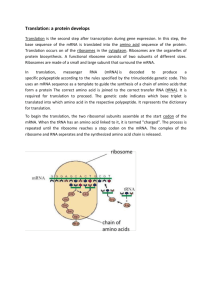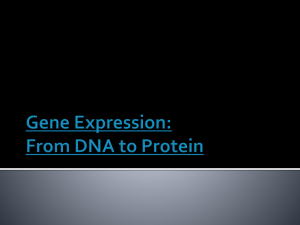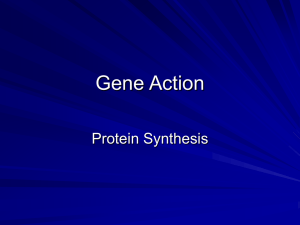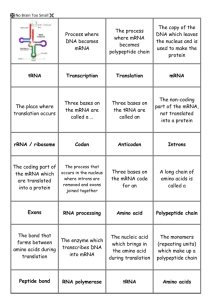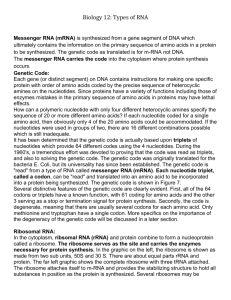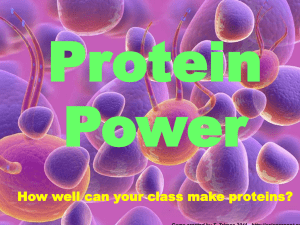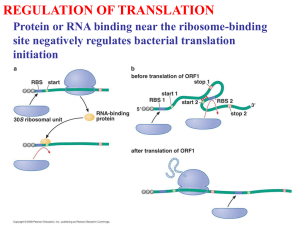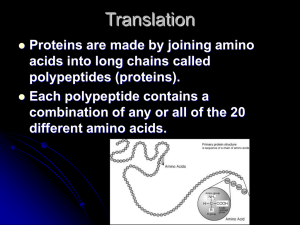What meaning(s) do these two photos represent? (Hint* dna,rna
advertisement
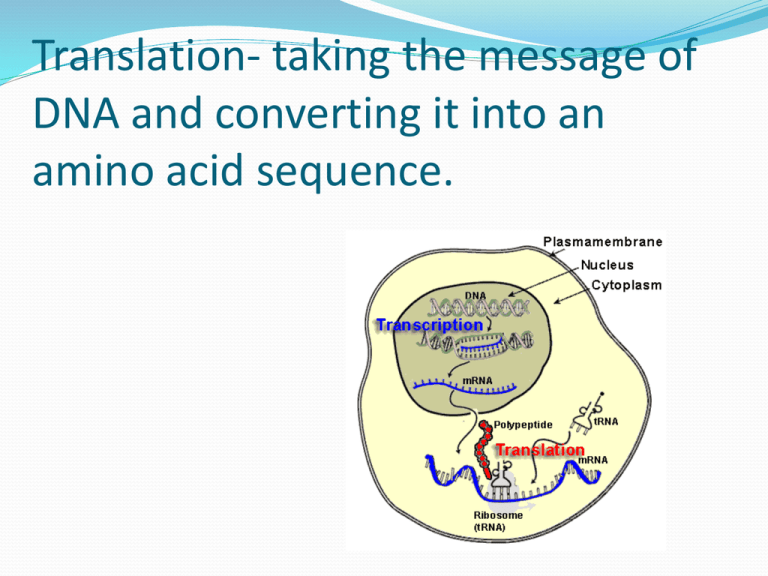
Translation- taking the message of DNA and converting it into an amino acid sequence. Genes (DNA) to RNA to Proteins (Traits) Overview Protein synthesis can be summarized in 2 main steps: Transcription: One of the 2 strands of DNA is transcribed into a single stranded messenger RNA, which carries the DNA message to the ribosome. Translation:The ribosome reads the messenger RNA and assembles the appropriate sequence of amino acids Post-transcription Processing Process between transcription and translation Pre-mRNA molecule produced and undergoes processing and editing. Introns – cut out and discarded Exons – remaining pieces spliced back together to form mRNA • mRNA travels through nuclear membrane pore into cytoplasm Genes Contain Introns Introns and exons why? Evolution, spliced in different ways in different tissues enabling one gene to produce several forms of mRNA, which can make several forms of a protein. Takes a lot of energy to make initial large molecule. Rule for gene expression, use to state until the 1990s: 1 gene = 1 protein Not true any more 1 gene = can make many proteins Translation Occurs at the Ribosome in the Cytoplasm Necessary materials: Ribosomes (rRNA and proteins), mRNA, tRNA, amino acids Produces proteins (traits) by connecting amino acids together with peptide bonds Uses codons on mRNA to determine amino acid sequence = genetic code Codons Codon= sequence of 3 nucleotides on mRNA that codes for one amino acid or a start or stop signal during translation. Each codon 3-lettered (bases) code codes for one amino acid 4 x 4 x 4= 64 possible triplet combinations First codon discovered- UUU= phenylalanine Codon-Amino Acid chart or wheel. Codon-Amino Acid Table How many start and stop codons are present? Practice mRNA AUGUCCACGGGAUGA AUGGGAAGACUAUAA All living organisms and viruses use this triplet genetic code - its that "biological unity" idea again!!! How does translation relate to YOUR life? (Why do you need to know this, anyway?) All the proteins that make up YOU, your cells, your body, the foods you eat, all the living cells in the world, etc - are made this way! Every time your body needs more of a protein muscle protein, hair protein, enzymes, hormones, hemoglobin molecules, a gene carrying the information for that protein is transcribed into mRNA, and the mRNA is made into protein! Structure of Ribosomes tRNA (anti-codons, amino acids) and mRNA (codons) Translation Ribosome has 3 sites. Ribosome can hold 1 mRNA strand and 2 tRNA molecules at a time. 400 amino acids in 20 seconds The steps of translation: 1. Initiation: mRNA enters the cytoplasm and becomes associated with ribosomes (rRNA + proteins). 2. Elongation: addition of amino acids one-by-one: As the ribosome moves along the mRNA, the tRNA transfers its amino acid to the growing protein chain, producing the protein - codon by codon! 3. Termination: when the ribosomes hits a stop codon UAA, UGA, or UAG - the ribosome falls apart! The same mRNA may be used hundreds of times during translation by many ribosomes before it is degraded (broken down) by the cell. http://glencoe.mcgraw- hill.com/sites/0078802849/student_view0/unit3/chap ter12/concepts_in_motion.html# Practice – DNA-mRNA-tRNA-amino acid DNA TACAATGCCGTAATT mRNA (codon) tRNA (anti-codon) Amino acids Protein Be able to determine patterns in all directions Practice-Keratin Types of Mutations Point mutation Substitution- wrong nucleotide base put in place No protein made Protein made without function (different AA in place) No effect (ie 2 different codons for same AA) Insertion/Duplicaton (addition)extra nucleotide placed in sequence- frameshift mutation Deletion (subtraction)- one fewer nucleotide is placed in sequenceframeshift mutation One mutation, can cause a completely new amino acid sequence to form: often called frameshift mutations Shift triplet codes Example CCUAGCAUUGCA CCUGCAUUGCA Mutations Other Chromosomal Mutations Inversion- reverses the direction of parts of a chromosome Translocation- part of a chromosome breaks off and attaches to another i.e. Down’s syndrome Extra piece of C. 21 is found. Gene Regulation Genes are turned on and off as needed by the cell. Prokaryotes Promoter, operator, repressor protein, genes Ex. Lac operon- if lactose present E. coli makes proteins to break down lactose- lactose binds to repressor protein which detaches from the operator – the operator is switched on and RNA polymerase can move along gene making mRNA. Lac operon Operon continued Eukaryotes- regulation More complicated with more regulatory proteins. Regulatory proteins= transcription factors Enhancer, activator, promoter, transcription factor, RNA polymerase. No operator Activators increase attraction of RNA polymerase for the promoter Textbook page 215
